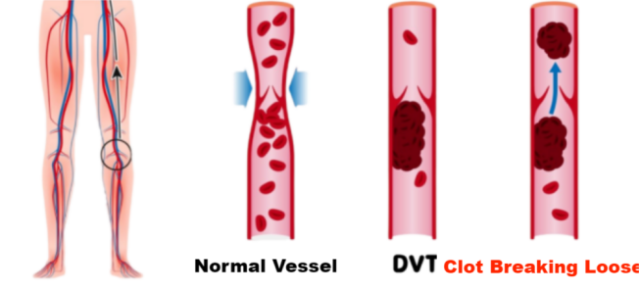Our body is like a vast city, where blood vessels form an intricate network of roads. Blood flows through them like vehicles, continuously delivering oxygen and nutrients to sustain the proper functioning of our organs. However, just as traffic jams frequently occur in a city, our vessels can also experience severe “congestion.” When arteries are blocked, it may lead to serious conditions such as myocardial infarction, angina, or cerebral infarction. When veins are blocked, the condition is known as Venous Thromboembolism (VTE).
How dangerous is VTE?
Venous thromboembolism (VTE), which includes deep vein thrombosis (DVT) and pulmonary embolism (PE), is the third most common vascular disease after ischemic heart disease and stroke. VTE doesn’t only occur in hospitals — it can also happen in everyday life. For instance, sitting still for long periods during flights, train rides, or car trips can lead to what’s commonly known as “economy class syndrome,” a form of VTE.

“Economy class syndrome" refers to poor blood circulation caused by sitting for a long time and reduced lower limb activity, which in turn leads to deep vein thrombosis (DVT). If a blood clot breaks loose and travels to the lungs, it can cause a pulmonary embolism (PE), which can be life-threatening in severe cases. That’s why VTE prevention and treatment matter, not just for patients in hospitals, but for everyone in daily life!
Who are the high-risk groups for VTE?
1. People who sit or stay in bed for long periods (e.g., during long-distance travel, extended game sessions like mahjong or cards, or late-night entertainment)
2. Patients recovering from surgeries, especially after fractures
3. People with pre-existing lower limb vascular conditions (e.g., varicose veins or a history of lower limb thrombosis)
4. People who are elderly, smokers, obese, postpartum, or those with trauma or burns
Why is it important to establish VTE prevention and treatment centers?
VTE is a common complication among inpatients, with a particularly high incidence in high-risk groups such as those undergoing surgery, cancer treatment, or prolonged bed rest. The symptoms of VTE are often non-specific and varied, making it easy to miss or misdiagnose.

To address this challenge, SSMC has actively responded to the national call by making every effort to establish a VTE prevention and treatment center. We have taken the lead in establishing Pingshan’s First IT Center for the Prevention and Treatment of VTE, aiming to enhance patient safety and improve medical quality through MDT collaboration, standardized clinical practices, and intelligent management. As a high-level medical center in eastern Shenzhen, our hospital remains committed to the philosophy of putting patients first and is dedicated to providing high-quality medical services. Establishing the VTE prevention and treatment center is not only a proactive response to national healthcare policies, but also a major step to enhance medical quality and patient safety.
How are we advancing the establishment of the VTE prevention and treatment center?
• Building a Comprehensive Prevention and Treatment Network through MDT Collaboration
The prevention and treatment of VTE involves multiple disciplines, including vascular surgery, respiratory medicine, critical care, oncology, and orthopedics. The VTE Center leverages a MDT collaboration model to integrate departmental resources and establish a hospital-wide prevention and treatment network that spans the entire continuum of care. Through regular MDT consultations, case discussions, and academic exchanges, the center ensures that all VTE-related practices are both scientifically conducted and standardized.
• Balanced Focus on Intelligent Risk Assessment and Prevention
The VTE Prevention and Treatment Center has developed an intelligent risk assessment system based on an IT platform. This system automatically extracts clinical data from patients and applies internationally recognized VTE risk assessment models to generate real-time risk reports. Based on the identified risk level, it then recommends personalized prevention plans tailored to each patient. This approach significantly improves the accuracy and efficiency of risk assessments, ensuring that every patient receives scientific, standardized preventive care.
• Standardized Clinical Pathways to Improve Treatment Efficiency
The VTE Prevention and Treatment Center is committed to designing a standardized clinical process to ensure that every step, from diagnosis to treatment, is efficient and well-regulated. By leveraging advanced imaging technologies and other tools, the center aims to improve early detection rates of VTE. At the same time, a rapid response mechanism will be established to ensure that patients with suspected VTE receive timely and effective treatment and cure.
• Enhancing Patient Education and Follow-Up Management
Effective VTE prevention and treatment rely not only on the hospital’s medical abilities, but also on active patient participation. SSMC will promote VTE prevention awareness to patients and their families through health education, public lectures, and other initiatives, aiming to raise public awareness and understanding of the disease and its prevention. At the same time, a comprehensive follow-up system will be established to provide long-term monitoring for discharged patients, ensuring continuity and effectiveness of care.
To date, SSMC has received and treated multiple VTE referral cases from within the district. Under the care of a professional medical team, these patients have fully recovered, demonstrating SSMC’s clinical expertise in VTE management and offering hope and reassurance to patients across the district. As the first IT Center for the Prevention and Treatment of VTE in Pingshan District, we believe that this center will enable SSMC to provide safer and more efficient medical services, safeguard vascular health, and better protect the well-being of our community.
